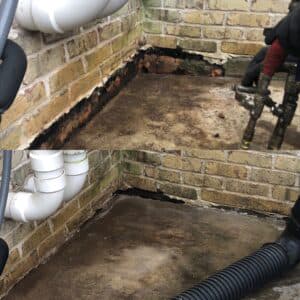Granular Soil and Its Effect on Your Foundation

If you search for information about expansive soil, you’ll find a number of articles about what it is and how it affects your foundation. But what if you don’t have expansive soil? In all likelihood, it means your home is built on granular soil. No one in our industry says much about that type of soil- but they should, because it comes with risks as well.
Acculevel has been repairing foundations and waterproofing homes since 1996. Over the years, we’ve helped more than 30,000 homeowners in Indiana and the surrounding areas restore health and stability to their homes. We want to educate homeowners about the variables that can play a role in damaging your home, and how to recognize them.
In this article, we’ll explain how you can determine if you have granular soil, when it could be an issue, and what symptoms to watch for.
What is Granular Soil?
The best way to determine your soil type is by scooping up a small amount of dirt out of your yard. When you add a bit of water to it, does it lump together and hold its shape? If it does, you have expansive, or clay-based, soil.
If the earth won’t pack together, it’s granular soil. Granular soil is made up of silt or loam (coarsely grained soil) with bits of sand and/or gravel in it. It’s a more loosely textured soil that crumbles easily when it’s dry.
How Granular Soil Can Damage Your Home’s Foundation
Quick flashback to grade school science: erosion! Erosion is what happens when water washes soil away from an area, exposing the layers below it.
Since granular soil doesn’t pack together when it gets wet, the particles of dirt are easily separated by water. This means they are easier to move or erode than clay-based soils. When soil under your foundation begins to erode, it means there is less support for your foundation. This causes sinking or uneven settling, which threatens the stability of your home.
Repair Methods for Erosion
The repair method for erosion damage depends on where the erosion occurs.
Slabjacking Can Solve Erosion Problems
In the two photos below, erosion had washed away the ground below the basement floor. The basement walls (the load-bearing part of the foundation) have not been adversely affected.
For this type of repair, slabjacking is the best choice. Slabjacking is a type of concrete levelling that can raise a sunken concrete slab back into position. It uses a polyurethane foam to fill the gap left by erosion; as the foam expands, it raises the slab.
You can see that the floor has dropped a full brick’s height in one corner. Small holes were drilled through the concrete, the slabjacking foam was injected through them, and the floor was lifted back into position. The brick foundation was undisturbed.
 Both photos were taken by Acculevel employees. The before (top) photo shows how the basement floor is sinking. The after photo (bottom) shows the floor after being slabjacked.
Both photos were taken by Acculevel employees. The before (top) photo shows how the basement floor is sinking. The after photo (bottom) shows the floor after being slabjacked.
Helical Piers Are Needed for Foundation Stabilization
If water has eroded the ground below a foundation wall, that type of repair is going to require helical piers. This is because slabjacking can only lift a concrete slab like a floor, patio, or driveway. Polyurethane foam doesn’t have the ability to lift something with the weight of a building on top of it.
Not familiar with the symptoms of a settling foundation? This article reviews how you can check for potential signs of settling.
Helical piers are steel posts with curved ‘blades’ that screw into the ground next to your foundation. The piers need to reach the stable, undisturbed soil that will lock them in place. Once they’ve reached the necessary depth (determined by a specialized pressure gauge), they are then attached to the foundation. The sketch below shows how this looks, for clarification.

The primary goal of piers is to stabilize the foundation so it will not move any farther. If the house has not settled too significantly, you may also be able to lift the foundation up close to its original position.
Protect Your Home Against Granular Soil
There are some steps you can take to offset the effects of granular soil. Most of these are about limiting the water next to your foundation and routing it away.
- The ground around your home should be well-graded, so that rainwater moves naturally away from your foundation.
- Check and clean your guttering at least twice a year, to keep it cleared and properly functioning. Clogs can cause rainwater to overflow the guttering and pool closer to your home.
Route your downspouts to drain at least 10 feet away from your foundation.
What’s the Next Step?
Do you need more information about foundation problems and repair methods? Refer to our Foundation Repair Guide. This is a free and detailed resource we developed for homeowners, addressing your concerns and responding to your questions.
If you need foundation repairs now, find a local and reputable foundation repair company. We recommend that you verify that they are insured and accredited by the Better Business Bureau. A good contractor will behave professionally, treat you with respect, and provide a free written estimate that clearly and specifically details the costs.
Of course, if you live in Indiana or the surrounding areas, you can contact Acculevel. We have a 5 star customer service rating, offer free written estimates, and provide whole-home solutions to preserve your home’s health and restore stability to your foundation. You can reach us at 866-669-3349 or by filling out this contact form.
